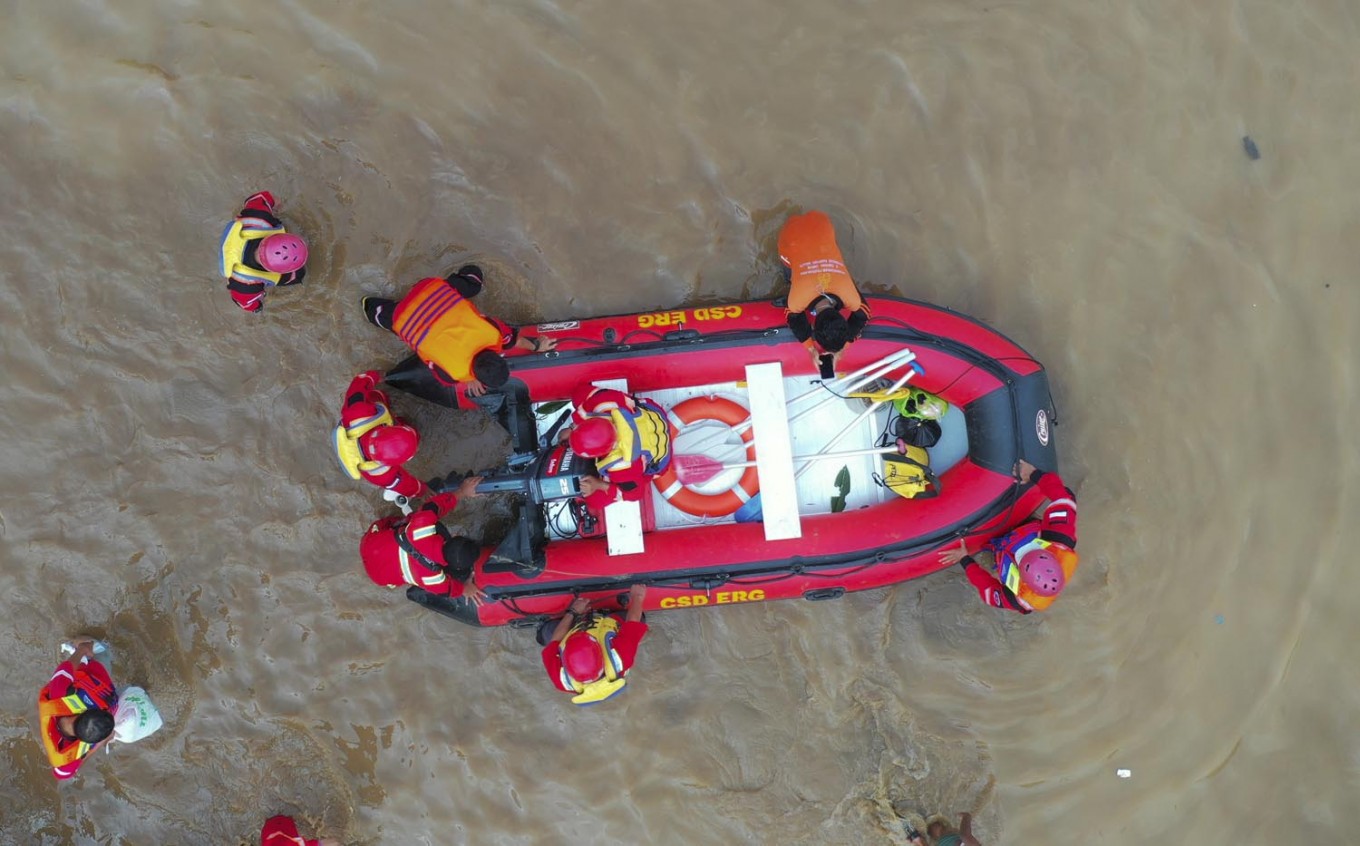Popular Reads
Top Results
Can't find what you're looking for?
View all search resultsPopular Reads
Top Results
Can't find what you're looking for?
View all search resultsSix common diseases to watch out for during floods
Those affected by floods are at risk of getting infected with water-borne diseases contracted through direct contact with polluted waters.
Change text size
Gift Premium Articles
to Anyone
T
he torrential rains that caused massive floods in Greater Jakarta on New Year’s Eve may have subsided, but the rainy season is far from over, meaning more floods are likely.
Those affected by floods are at risk of getting infected with water-borne diseases contracted through direct contact with polluted waters. Floods also serve as a prime breeding site for mosquitoes, which also transmit many vector-borne diseases.
According to the World Health Organization (WHO), there are six diseases or health problems in particular that are worth looking out for during floods:
1. Typhoid fever
Typhoid fever is a bacterial infection caused by Salmonella Typhi. Once the bacteria enters the body, it multiplies and spreads into the bloodstream, causing symptoms like prolonged fever, fatigue, headache, nausea, abdominal pain and constipation or diarrhea.
Typhoid fever can be life-threatening if untreated.
It is spread by eating food or drinking water contaminated with the feces of an infected person. Poor sanitation and poor hygiene during floods can increase the risk of typhoid outbreaks. According to WHO, a cyclone and flooding in Mauritius in 1980 led to an outbreak of typhoid fever.
Drinking clean water and adequate sanitation and hygiene among food handlers, alongside typhoid vaccinations, are all effective in preventing typhoid fever. Frequent handwashing also helps prevent the disease.
2. Cholera
Cholera is an acute infectious diarrhoeal disease caused by ingestion of bacterium Vibrio cholerae. The bacterium causes severe watery diarrhea, which can lead to dehydration and even death within hours if left untreated.
Cholera is transmitted by eating food or drinking water contaminated with the bacterium. Lack of access to clean water and sanitation facilities, which commonly occurs during floods, can increase the transmission of the disease. In 1998, floods in West Bengal led to a large cholera epidemic.
Similar to typhoid fever, cholera can be prevented by drinking clean water and adequate sanitation.
3. Hepatitis A
Hepatitis A is a highly contagious liver infection caused by Hepatovirus A (HAV). The virus is transmitted through ingestion of water or food that is contaminated with the feces of an infected person or through direct contact with an infectious person.
Symptoms of hepatitis A include fever, malaise, loss of appetite, diarrhea, nausea, abdominal discomfort, dark-colored urine and jaundice (yellowing of the skin and whites of the eyes).
Improved sanitation, food safety and immunization can prevent the disease. Personal hygiene practices such as regular hand-washing before meals and after going to the bathroom is also effective in combating hepatitis A.
Read also: At least 19 deaths reported as floods, landslides strike Greater Jakarta
4. Malaria
Malaria is a life-threatening infectious disease caused by Plasmodium parasites. The parasites are transmitted to people through the bites of infected female Anopheles mosquitoes.
Malaria causes symptoms that typically include fever, tiredness, vomiting and headaches. In severe cases it can cause yellow skin, seizures, coma or death.
Malaria epidemics after flooding are a well-known phenomenon, especially in malaria-endemic areas. According to data from WHO, in 1991 an earthquake and subsequent flooding in Costa Rica's Atlantic region and flooding in the Dominican Republic in 2004 led to malaria outbreaks.
The risk of disease can be reduced by preventing mosquito bites through the use of mosquito nets and insect repellents, or through mosquito control measures such as spraying insecticides and draining standing water.
5. Dengue fever
Dengue is a mosquito-borne viral infection caused by the dengue virus, which can lead to a severe flu-like illness, sometimes causing a potentially lethal complication called severe dengue. The virus is commonly transmitted through the bite of Aedes aegypti mosquitoes.
The spread of the dengue virus results in viremia, which indicates a high level of the virus in the bloodstream. Severe dengue can be life-threatening within a few hours and often requires hospitalization.
The global rate of incidence of dengue has grown dramatically in recent decades. Severe dengue is a leading cause of serious illness and death among children and adults in some Asian and Latin American countries.
The most common symptom of dengue is fever with nausea, vomiting, rash and aches and pains in eyes, muscles, joints or bones.
Use of insect repellents is recommended to avoid mosquito bites.
6. Hypothermia
Since the start of the New Year’s Day floods in Jakarta on Tuesday, the National Disaster Mitigation Agency (BNPB) has reported three deaths caused by hypothermia.
Hypothermia is a medical emergency that occurs when the body loses heat faster than it can produce heat, causing a dangerously low body temperature (below 35 degrees Celsius).
Children and elderly people are more at risk of hypothermia during floods.
Symptoms depend on the severity of the hypothermia. In mild hypothermia, there is shivering and mental confusion. In moderate hypothermia, there is an increased risk of mental confusion, slurred speech and decreased reflexes when the shivering stops. In severe hypothermia, cold inflamed skin, hallucinations, a lack of reflexes, fixed dilated pupils, low blood pressure and paradoxical undressing, in which a person removes their clothing, can occur.
Appropriate clothing (dry and warm clothes) helps to prevent hypothermia. (nal/kes)











